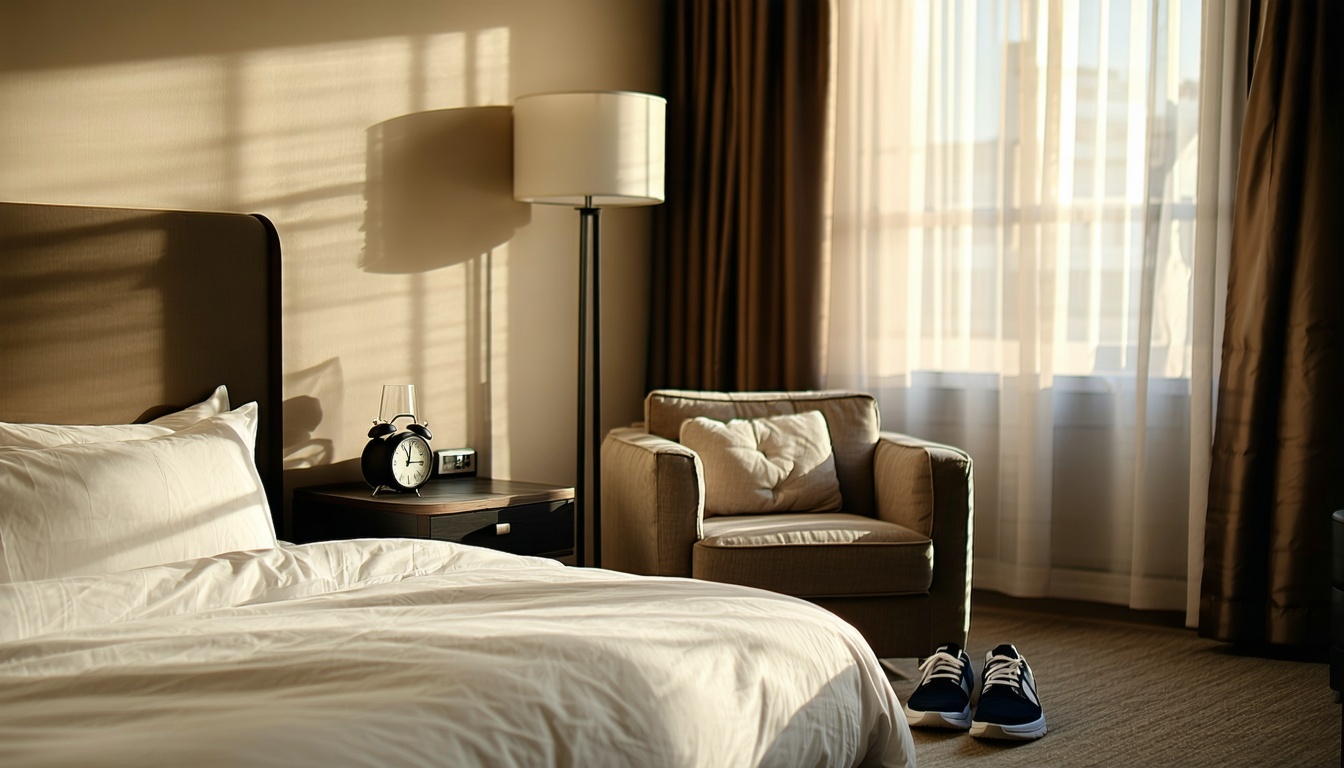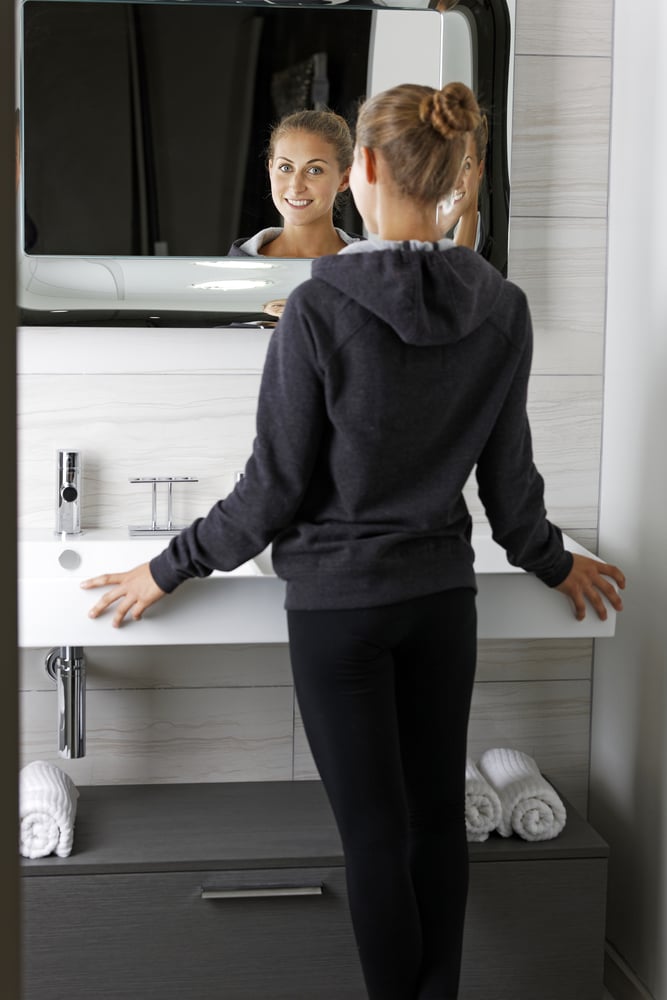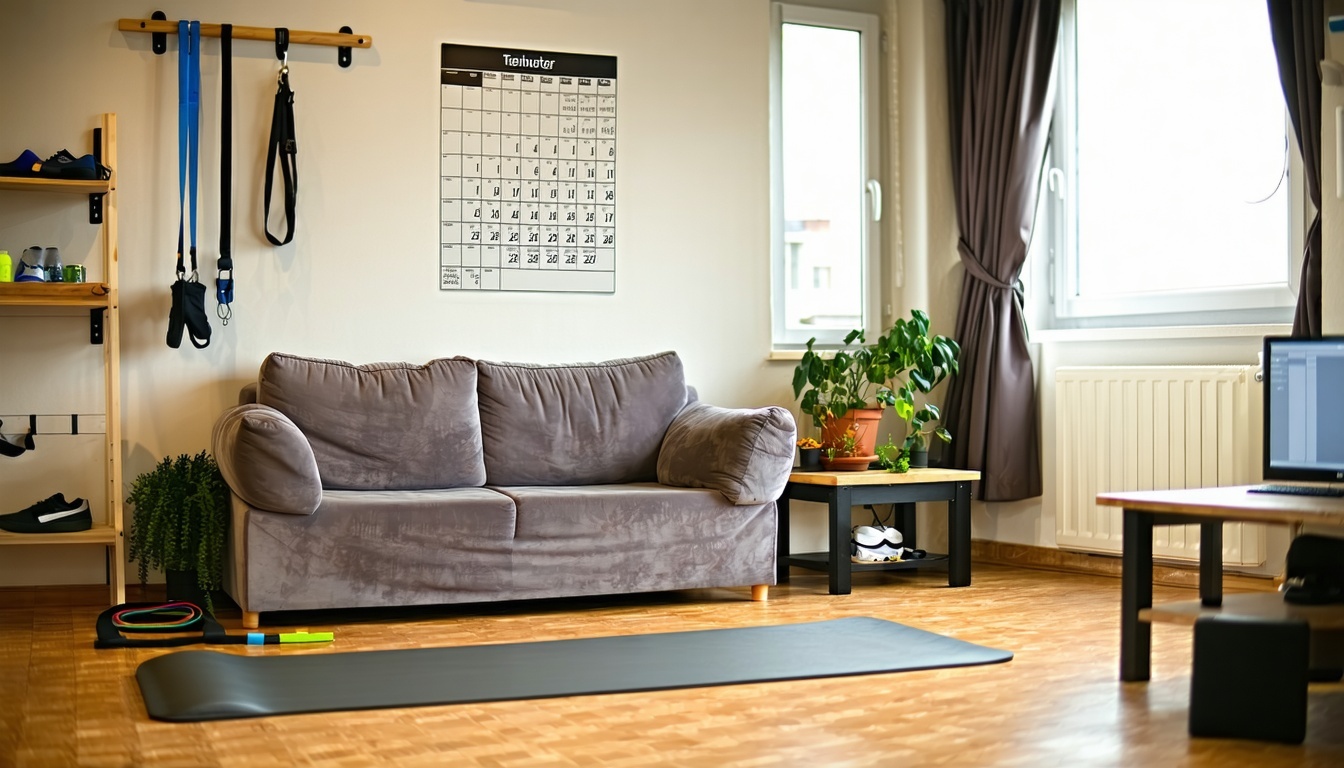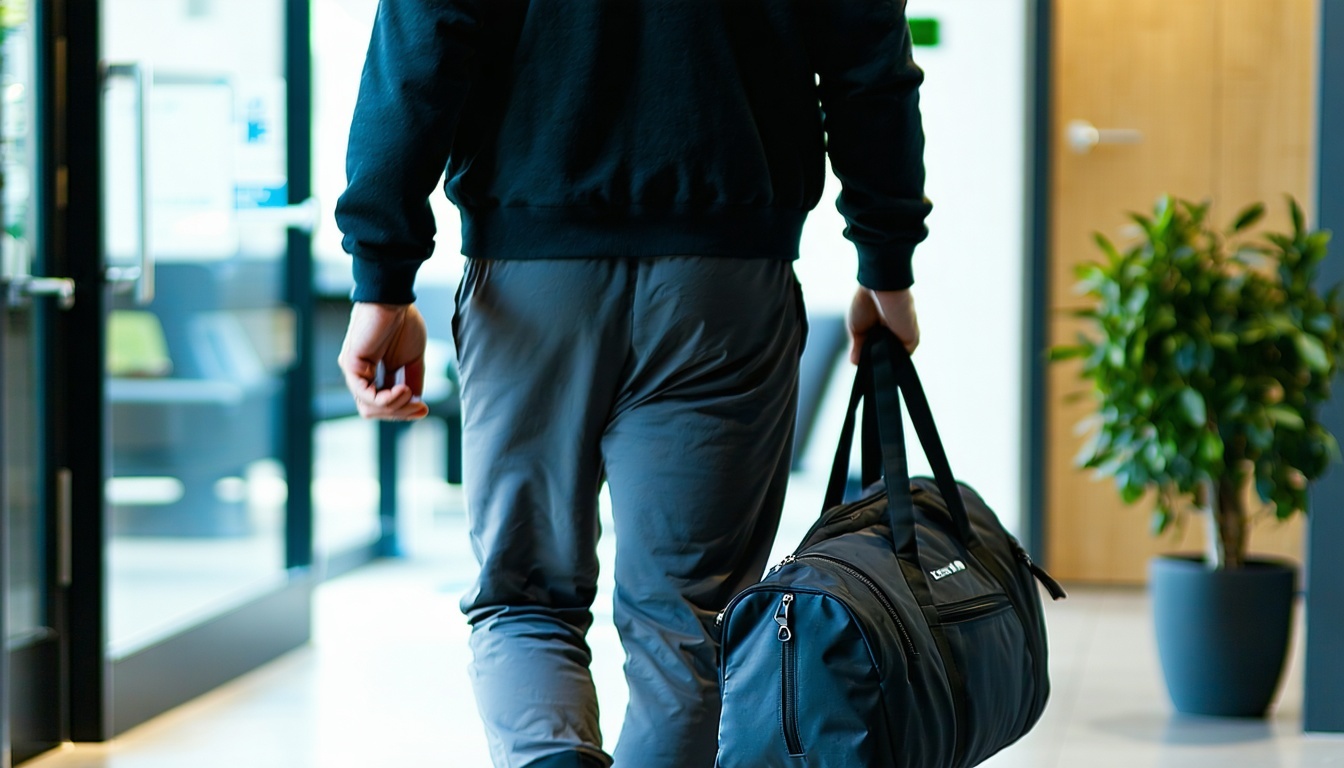The Complete Quiet Hotel Room Workout (No Jumping, No Noise, Maximum Results)
Quick Answer
A complete quiet hotel room workout uses wall push-ups, bed-based exercises, silent squats, and floor work. This 20-minute routine requires only 6x3 feet of space, makes no noise, and provides a full-body workout without disturbing other guests.
The Hotel Room Fitness Challenge
You're in a hotel room at 6 AM, jet-lagged and stiff from travel, but determined not to let your fitness routine completely derail. The problem? The guest below you is probably still sleeping, the walls are paper-thin, and your usual workout involves enough jumping and stomping to wake half the floor.
Here's the thing about hotel fitness: it's not about recreating your home gym experience. It's about working with the constraints—limited space, noise restrictions, no equipment—to create something that actually works better than most people's regular routines.
This isn't a compromise workout. It's a strategic approach to fitness that uses the unique features of hotel rooms (beds, walls, limited space) to create resistance, stability, and challenge in ways you might never have considered.
Space and Noise Requirements
Minimum Space Needed
Most hotel room workouts need surprisingly little space:
- Floor space: 6 feet by 3 feet (the area between bed and wall)
- Wall access: Any wall space for push-ups and wall sits
- Bed edge: For tricep dips, step-ups, and incline exercises
- Bathroom space: Optional for additional privacy and hard surfaces
Noise Considerations
Hotel room workouts must be neighbor-friendly:
Avoid These Noisy Activities:
- Jumping jacks, burpees, or any jumping movements
- Running or marching in place
- Dropping weights or equipment
- High-impact movements that create floor vibration
Silent Alternatives That Work Better:
- Controlled bodyweight movements
- Isometric holds and static exercises
- Slow, deliberate movements with longer time under tension
- Resistance exercises using hotel room furniture
The Complete 20-Minute Silent Hotel Room Routine
Phase 1: Silent Warm-Up (5 minutes)
Prepare your body without making a sound:
Gentle Joint Mobility (2 minutes)
- Neck rolls: 5 slow circles each direction
- Shoulder rolls: 10 backward, 10 forward
- Arm circles: 10 small, 10 large each direction
- Hip circles: 10 each direction
- Ankle circles: 10 each direction, each foot
Dynamic Stretching (3 minutes)
- Standing forward fold: Hold 30 seconds
- Standing quad stretch: 30 seconds each leg
- Standing figure-4 stretch: 30 seconds each leg
- Gentle torso twists: 10 each direction
- Cat-cow stretches: 10 repetitions (on hands and knees)
Phase 2: Upper Body Circuit (5 minutes)
Build upper body strength using hotel room features:
Wall Push-Ups (1 minute)
- Stand arm's length from wall
- Place palms flat against wall at shoulder height
- Perform slow, controlled push-ups
- Focus on 2 seconds in, 2 seconds out
- Aim for 15-20 repetitions
Bed Edge Tricep Dips (1 minute)
- Sit on edge of bed, hands gripping the mattress edge
- Slide forward so your weight is supported by your arms
- Lower your body by bending your elbows
- Push back up to starting position
- Aim for 10-15 repetitions
Incline Push-Ups on Bed (1 minute)
- Place hands on the bed edge, body in plank position
- Perform push-ups with your hands elevated
- This is easier than floor push-ups but still effective
- Aim for 12-18 repetitions
Isometric Wall Sit (1 minute)
- Back against wall, slide down until thighs are parallel to floor
- Hold this position, engaging your core
- This works legs but also engages your entire core
- Hold for 30-60 seconds
Plank Hold (1 minute)
- Standard plank position on the floor
- Keep your body in a straight line
- Engage core, glutes, and shoulders
- Hold for 30-60 seconds
Phase 3: Lower Body Circuit (5 minutes)
Strengthen your legs without any jumping or noise:
Silent Squats (1 minute)
- Feet shoulder-width apart
- Lower slowly into squat position (3 seconds down)
- Pause at the bottom for 1 second
- Rise slowly (3 seconds up)
- Focus on control, not speed
- Aim for 10-15 slow, controlled repetitions
Reverse Lunges (1 minute)
- Step backward into lunge position
- Lower your back knee toward the floor
- Push through your front heel to return to standing
- Alternate legs or do all reps on one side first
- Aim for 10-12 per leg
Bed-Based Glute Bridges (1 minute)
- Lie on your back, feet flat on the bed edge
- Lift your hips up, squeezing your glutes
- Hold for 2 seconds at the top
- Lower slowly and repeat
- Aim for 15-20 repetitions
Single-Leg Calf Raises (1 minute)
- Hold onto the wall or bed for balance
- Rise up on one foot, lifting onto your toes
- Lower slowly and repeat
- Switch legs halfway through
- Aim for 15-20 per leg
Wall Sit Hold (1 minute)
- Back against wall, slide down into sitting position
- Thighs parallel to floor, knees at 90 degrees
- Hold this position, breathing steadily
- Hold for 30-60 seconds
Phase 4: Core Strengthening (3 minutes)
Target your core with silent, effective exercises:
Modified Crunches (1 minute)
- Lie on your back, knees bent, feet flat on floor
- Place hands behind head (don't pull on neck)
- Lift shoulder blades off floor, engaging abs
- Lower slowly and repeat
- Aim for 15-25 repetitions
Dead Bug Exercise (1 minute)
- Lie on back, arms extended toward ceiling
- Knees bent at 90 degrees, shins parallel to floor
- Slowly extend opposite arm and leg
- Return to start and switch sides
- Aim for 10-12 per side
Side Plank Hold (1 minute)
- Lie on your side, propped up on your elbow
- Lift your hips, creating a straight line from head to feet
- Hold for 15-30 seconds, then switch sides
- Repeat 2-3 times per side
Phase 5: Cool-Down and Flexibility (2 minutes)
End with gentle stretches to release tension:
Seated Spinal Twist (30 seconds)
- Sit on bed edge, twist gently to each side
- Hold for 15 seconds per side
Standing Forward Fold (30 seconds)
- Let your arms hang heavy, gentle sway side to side
Chest Opener Stretch (30 seconds)
- Clasp hands behind back, lift chest
- Great for counteracting travel posture
Hip Flexor Stretch (30 seconds)
- Step one foot back, gentle lunge position
- 15 seconds per side
Advanced Hotel Room Techniques
Using Hotel Room Furniture Creatively
The Bed as Equipment:
- Incline surface: For easier push-ups and planks
- Resistance platform: For glute bridges and leg exercises
- Step platform: For step-ups (if bed is appropriate height)
- Support structure: For tricep dips and stretching
Walls for Resistance:
- Push-up surface: Adjustable difficulty based on distance
- Wall sit support: For isometric leg strengthening
- Stretching aid: For calf stretches and hip flexor stretches
Bathroom Space:
- Hard surfaces: Better for certain floor exercises
- Privacy: If you're sharing a room
- Mirror feedback: Check your form
- Towel storage: Easy access to towels for exercises
Intensity Modifications
Making Exercises Easier:
- Increase incline for push-ups (hands higher)
- Reduce range of motion for squats and lunges
- Hold positions for shorter durations
- Take longer rest periods between exercises
Making Exercises Harder:
- Slow down the tempo (3 seconds down, 3 seconds up)
- Add pauses at the most challenging part of each movement
- Increase hold times for isometric exercises
- Add single-limb variations (single-leg squats, one-arm planks)
Travel-Specific Considerations
Jet Lag and Energy Management
Morning Workouts (Eastward Travel):
- Keep the routine gentle if you're fighting to stay awake
- Focus on mobility and light movement to combat stiffness
- Use the workout to help reset your circadian rhythm
Evening Workouts (Westward Travel):
- Can be more intense since you might have extra energy
- Avoid too much intensity close to desired bedtime
- Focus on stress-relieving movements
Business Travel Modifications
Pre-Meeting Preparation:
- Focus on posture-improving exercises
- Include stress-reducing movements
- Keep intensity moderate to avoid sweating
- End with breathing exercises for mental clarity
Post-Meeting Recovery:
- Emphasize stress relief and tension release
- Include more stretching and mobility work
- Can be more intense since you have time to shower
Different Hotel Room Types
Small Rooms:
- Focus on bed-based and wall exercises
- Use the bathroom for additional space if needed
- Emphasize vertical movements over horizontal ones
Suite-Style Rooms:
- Take advantage of additional floor space
- Can include more dynamic movements
- Use furniture creatively for additional exercise variations
Shared Rooms:
- Consider bathroom workouts for privacy
- Choose quieter exercises to avoid disturbing roommates
- Coordinate timing with your roommate's schedule
Troubleshooting Common Hotel Workout Challenges
"I'm Too Self-Conscious"
Hotel room workouts can feel awkward at first:
- Remember privacy: You're in your own space
- Start small: Begin with just stretching to build comfort
- Focus on benefits: How you'll feel after, not how you look during
- Use the bathroom: Extra privacy if you're sharing a room
"I Don't Have Workout Clothes"
You don't need special gear:
- Comfortable clothes: Anything you can move in
- Barefoot is fine: Better grip and quieter than shoes
- Business attire modifications: Remove jacket, loosen tie, roll up sleeves
- Pajamas work: Perfect for morning or evening routines
"The Room Is Too Small"
Work with what you have:
- Vertical exercises: Wall push-ups, wall sits, standing stretches
- Bed-based movements: Use the bed as your exercise platform
- Isometric holds: Require minimal space but maximum effort
- Bathroom overflow: Use bathroom space for additional room
"I'm Worried About Noise"
Be considerate but don't skip exercise:
- Test the floor: Walk around to gauge how much sound travels
- Use carpeted areas: Usually quieter than hard floors
- Avoid early/late hours: 6 AM - 9 PM is generally acceptable
- Focus on controlled movements: Slow and deliberate is quieter
Building a Sustainable Travel Fitness Routine
Consistency Strategies
Pack Preparation:
- Include comfortable clothes in your carry-on
- Pack a small towel for floor exercises
- Bring resistance bands if you have space (optional)
- Download workout videos for guidance
Routine Integration:
- Schedule workout time like any other appointment
- Use it as a way to combat jet lag
- Make it part of your morning or evening routine
- Track your consistency, not just your performance
Adapting to Different Trip Types
Short Business Trips (1-3 days):
- Focus on maintaining routine rather than intensity
- Use workouts to manage travel stress
- Emphasize posture and mobility work
Extended Travel (1+ weeks):
- Develop a more comprehensive routine
- Include progression and variety
- Consider local gym day passes for variety
- Make hotel workouts your consistent baseline
Vacation Travel:
- Keep routines lighter and more enjoyable
- Focus on movement that enhances your trip
- Use workouts to boost energy for activities
- Don't let perfect be the enemy of good
Frequently Asked Questions
Can you get a good workout in a hotel room without making noise?
Absolutely. You can get an excellent full-body workout using silent exercises like wall push-ups, bed-based exercises, isometric holds, and controlled floor work. The key is choosing movements that don't involve jumping, dropping, or impact with the floor. Many travelers find hotel room workouts more effective than they expected.
What exercises can I do in a hotel room without disturbing neighbors?
Focus on controlled movements like squats, lunges, wall push-ups, planks, tricep dips using the bed edge, and stretching routines. Avoid jumping jacks, burpees, running in place, or any exercises that create floor impact. Isometric exercises like wall sits and planks are particularly effective and completely silent.
How much space do I need for a hotel room workout?
You need approximately 6 feet by 3 feet of floor space—about the area between the bed and the wall in most hotel rooms. Many exercises can also be done on or using the bed itself. The bathroom can provide additional space if needed for privacy or more room.
Can I do cardio in a hotel room without jumping?
Yes, you can elevate your heart rate effectively with silent cardio alternatives like step-ups on the bed edge, wall sits, mountain climbers with hands on the bed, and circuit training with minimal rest between exercises. The key is maintaining continuous movement and shorter rest periods.
What time is appropriate for hotel room workouts?
Early morning (6-8 AM) or late afternoon/early evening (4-7 PM) are typically best. Avoid very early morning (before 6 AM) or late evening (after 9 PM) to be considerate of other guests. If you must exercise during off-hours, focus on the quietest exercises like stretching and breathing work.
Related Travel and Professional Fitness Solutions
Enhance your travel fitness strategy with these complementary approaches:
- Complete Guide to Staying Fit as a Busy Professional - Comprehensive strategies for maintaining fitness with demanding schedules
- Airport Terminal Walking Workout - Stay active during long layovers and delays
- In-Flight Exercise Routine for Long Flights - Combat travel stiffness and circulation issues
- Business Travel Fitness Packing Guide - Essential items for maintaining fitness on the road
- Jet Lag Recovery Through Strategic Exercise - Use movement to reset your circadian rhythm
Conclusion: Mastering Hotel Room Fitness
Hotel room workouts aren't a compromise—they're a skill. Once you master the art of silent, space-efficient exercise, you'll have a fitness superpower that works anywhere: tiny apartments, quiet offices, early morning routines when others are sleeping, or any situation where traditional workouts aren't practical.
The constraints of hotel rooms—limited space, noise restrictions, minimal equipment—force you to focus on what really matters: controlled movements, time under tension, and consistency. Many people discover that their hotel room workouts are more focused and effective than their regular gym sessions because there are no distractions, no waiting for equipment, and no excuses.
Travel doesn't have to derail your fitness routine. With this silent, space-efficient approach, you can maintain and even improve your fitness level regardless of where your work or adventures take you. The key is preparation, consistency, and embracing the unique advantages that hotel room workouts offer.
Your next business trip or vacation is an opportunity to prove that fitness isn't about having the perfect setup—it's about making the most of whatever space and time you have. Pack comfortable clothes, download this routine, and show yourself that you can stay fit anywhere.
The best workout is the one you actually do, and hotel room workouts remove every possible excuse. No gym membership required, no equipment needed, no commute time, and no noise complaints. Just you, a small space, and 20 minutes to take care of yourself no matter where in the world you are.




-1.jpg)
